Examining the Relationship: Taxation and Improved Governance
VerifiedAdded on 2022/08/30
|8
|2325
|15
Essay
AI Summary
This essay examines the relationship between increased taxation and better governance. It argues that progressive tax structures can curb income inequality and promote social justice. The paper discusses the use of progressive tax structures, citing the UK's experience with income inequality and the need for tax reform. It explores how tax increases can positively impact governance, referencing examples of health taxes and excise taxes in other countries. The essay also delves into the principles behind high taxation, the impact of tax policies on corruption, and the potential for increased taxes to reduce poverty and inequality. It acknowledges the hidden picture behind increased taxation, including potential economic drawbacks and political challenges. The conclusion emphasizes that while increased taxation may slow economic growth, it helps to balance the distribution of wealth and income and increase the happiness ratio in the form of social justice.
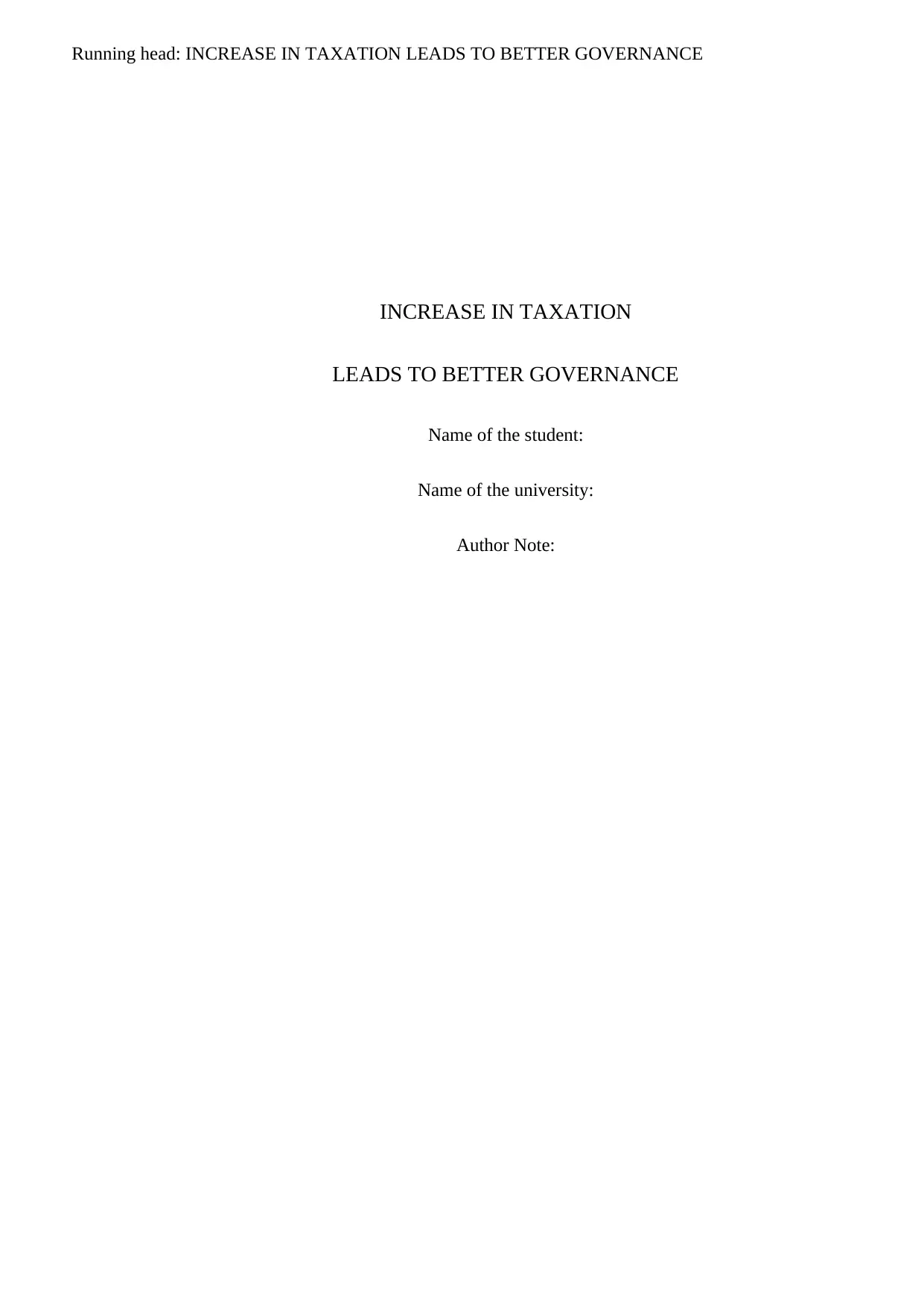
Running head: INCREASE IN TAXATION LEADS TO BETTER GOVERNANCE
INCREASE IN TAXATION
LEADS TO BETTER GOVERNANCE
Name of the student:
Name of the university:
Author Note:
INCREASE IN TAXATION
LEADS TO BETTER GOVERNANCE
Name of the student:
Name of the university:
Author Note:
Paraphrase This Document
Need a fresh take? Get an instant paraphrase of this document with our AI Paraphraser
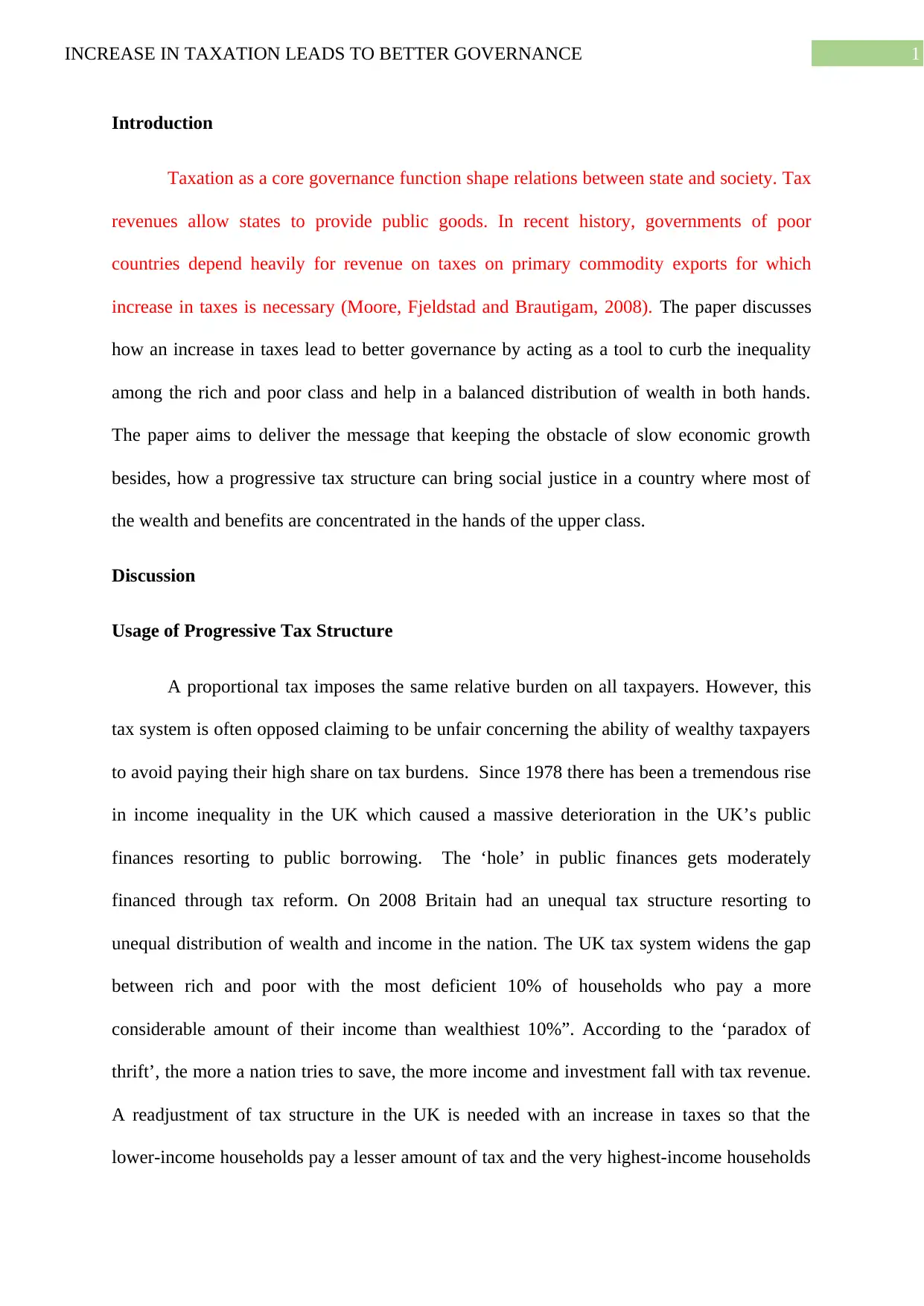
1INCREASE IN TAXATION LEADS TO BETTER GOVERNANCE
Introduction
Taxation as a core governance function shape relations between state and society. Tax
revenues allow states to provide public goods. In recent history, governments of poor
countries depend heavily for revenue on taxes on primary commodity exports for which
increase in taxes is necessary (Moore, Fjeldstad and Brautigam, 2008). The paper discusses
how an increase in taxes lead to better governance by acting as a tool to curb the inequality
among the rich and poor class and help in a balanced distribution of wealth in both hands.
The paper aims to deliver the message that keeping the obstacle of slow economic growth
besides, how a progressive tax structure can bring social justice in a country where most of
the wealth and benefits are concentrated in the hands of the upper class.
Discussion
Usage of Progressive Tax Structure
A proportional tax imposes the same relative burden on all taxpayers. However, this
tax system is often opposed claiming to be unfair concerning the ability of wealthy taxpayers
to avoid paying their high share on tax burdens. Since 1978 there has been a tremendous rise
in income inequality in the UK which caused a massive deterioration in the UK’s public
finances resorting to public borrowing. The ‘hole’ in public finances gets moderately
financed through tax reform. On 2008 Britain had an unequal tax structure resorting to
unequal distribution of wealth and income in the nation. The UK tax system widens the gap
between rich and poor with the most deficient 10% of households who pay a more
considerable amount of their income than wealthiest 10%”. According to the ‘paradox of
thrift’, the more a nation tries to save, the more income and investment fall with tax revenue.
A readjustment of tax structure in the UK is needed with an increase in taxes so that the
lower-income households pay a lesser amount of tax and the very highest-income households
Introduction
Taxation as a core governance function shape relations between state and society. Tax
revenues allow states to provide public goods. In recent history, governments of poor
countries depend heavily for revenue on taxes on primary commodity exports for which
increase in taxes is necessary (Moore, Fjeldstad and Brautigam, 2008). The paper discusses
how an increase in taxes lead to better governance by acting as a tool to curb the inequality
among the rich and poor class and help in a balanced distribution of wealth in both hands.
The paper aims to deliver the message that keeping the obstacle of slow economic growth
besides, how a progressive tax structure can bring social justice in a country where most of
the wealth and benefits are concentrated in the hands of the upper class.
Discussion
Usage of Progressive Tax Structure
A proportional tax imposes the same relative burden on all taxpayers. However, this
tax system is often opposed claiming to be unfair concerning the ability of wealthy taxpayers
to avoid paying their high share on tax burdens. Since 1978 there has been a tremendous rise
in income inequality in the UK which caused a massive deterioration in the UK’s public
finances resorting to public borrowing. The ‘hole’ in public finances gets moderately
financed through tax reform. On 2008 Britain had an unequal tax structure resorting to
unequal distribution of wealth and income in the nation. The UK tax system widens the gap
between rich and poor with the most deficient 10% of households who pay a more
considerable amount of their income than wealthiest 10%”. According to the ‘paradox of
thrift’, the more a nation tries to save, the more income and investment fall with tax revenue.
A readjustment of tax structure in the UK is needed with an increase in taxes so that the
lower-income households pay a lesser amount of tax and the very highest-income households

2INCREASE IN TAXATION LEADS TO BETTER GOVERNANCE
pay more through a progressive tax structure. Equity can be created when it is applied across
all taxes, and not just to anyone tax in isolation. The system is neither compassionate to the
poor, but in terms of economic harmony provides balance in the economy — the wealthiest
10% of the population account half of the government’s fiscal revenue. The Income-tax and
VAT account for the largest sources of revenue for government amounting to sixty per cent.
The VAT is the largest source, followed by corporate income and on the property (Ghodsi
and Webster 2018). Withdrawing the personal allowance paves the way for extra tax rates.
People with income between the level of 100 to 200 thousand pounds are losing fifty units of
the personal allowance for every extra pound earned. Further additional tax is also calculated
on child benefit to curb population density by reducing 1% for every £100 of earnings above
£50,000.
How Tax Increase Positively Impacted Governance
Tax is a political debate in the UK. Ninety-six per cent of people are in favour of a tax
system that should be more progressive than is currently the case. Increase in tax level is
considered to bring many benefits to the nation than the tax-cut. The tax policy decisions
should be more about wider macro-economic to the extent at which they enable the
government to realise objectives and the kind of economic system to which they contribute.
The UK should also increase their taxes through progressive taxation or add extra taxes to
certain commodities as adopted by other nations. Health taxes are suggested on foods to
combat the growing level of obesity and health-related disorders in a nation as a move for
better living. Hungary in 2011 has highly taxed foods with a high content of fats and sugar
while France in 2012 implemented high taxes on the high content of sweetened beverages.
(Madden 2015). China’s 2015 modest increase in the excise tax of cigarettes reduced the
smoking level in the country along with tobacco manufacture and distribution (Yu et al.,
2019). The excise tax represented 36.3% of the cigarette price in China, which was needed to
pay more through a progressive tax structure. Equity can be created when it is applied across
all taxes, and not just to anyone tax in isolation. The system is neither compassionate to the
poor, but in terms of economic harmony provides balance in the economy — the wealthiest
10% of the population account half of the government’s fiscal revenue. The Income-tax and
VAT account for the largest sources of revenue for government amounting to sixty per cent.
The VAT is the largest source, followed by corporate income and on the property (Ghodsi
and Webster 2018). Withdrawing the personal allowance paves the way for extra tax rates.
People with income between the level of 100 to 200 thousand pounds are losing fifty units of
the personal allowance for every extra pound earned. Further additional tax is also calculated
on child benefit to curb population density by reducing 1% for every £100 of earnings above
£50,000.
How Tax Increase Positively Impacted Governance
Tax is a political debate in the UK. Ninety-six per cent of people are in favour of a tax
system that should be more progressive than is currently the case. Increase in tax level is
considered to bring many benefits to the nation than the tax-cut. The tax policy decisions
should be more about wider macro-economic to the extent at which they enable the
government to realise objectives and the kind of economic system to which they contribute.
The UK should also increase their taxes through progressive taxation or add extra taxes to
certain commodities as adopted by other nations. Health taxes are suggested on foods to
combat the growing level of obesity and health-related disorders in a nation as a move for
better living. Hungary in 2011 has highly taxed foods with a high content of fats and sugar
while France in 2012 implemented high taxes on the high content of sweetened beverages.
(Madden 2015). China’s 2015 modest increase in the excise tax of cigarettes reduced the
smoking level in the country along with tobacco manufacture and distribution (Yu et al.,
2019). The excise tax represented 36.3% of the cigarette price in China, which was needed to
⊘ This is a preview!⊘
Do you want full access?
Subscribe today to unlock all pages.

Trusted by 1+ million students worldwide
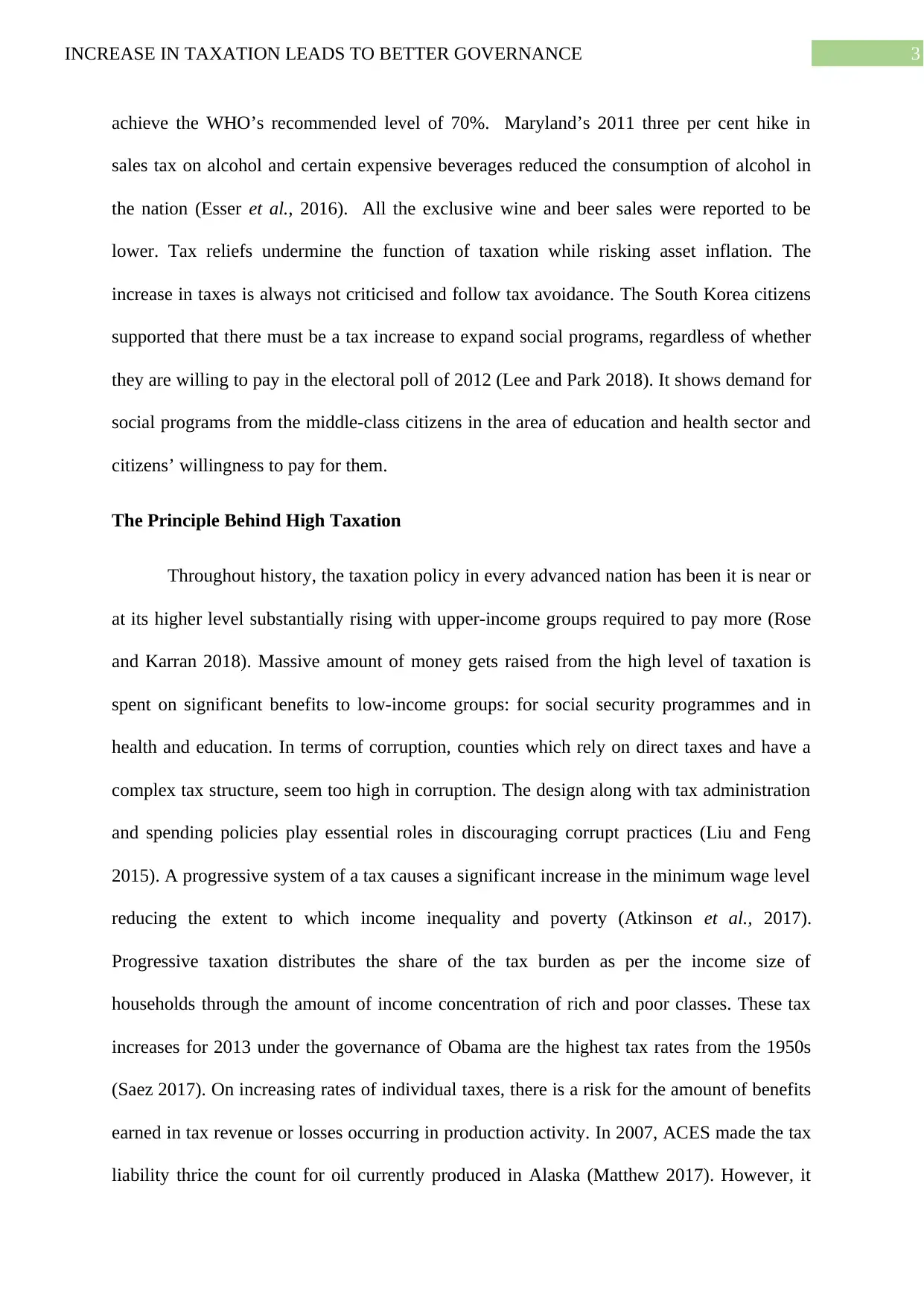
3INCREASE IN TAXATION LEADS TO BETTER GOVERNANCE
achieve the WHO’s recommended level of 70%. Maryland’s 2011 three per cent hike in
sales tax on alcohol and certain expensive beverages reduced the consumption of alcohol in
the nation (Esser et al., 2016). All the exclusive wine and beer sales were reported to be
lower. Tax reliefs undermine the function of taxation while risking asset inflation. The
increase in taxes is always not criticised and follow tax avoidance. The South Korea citizens
supported that there must be a tax increase to expand social programs, regardless of whether
they are willing to pay in the electoral poll of 2012 (Lee and Park 2018). It shows demand for
social programs from the middle-class citizens in the area of education and health sector and
citizens’ willingness to pay for them.
The Principle Behind High Taxation
Throughout history, the taxation policy in every advanced nation has been it is near or
at its higher level substantially rising with upper-income groups required to pay more (Rose
and Karran 2018). Massive amount of money gets raised from the high level of taxation is
spent on significant benefits to low-income groups: for social security programmes and in
health and education. In terms of corruption, counties which rely on direct taxes and have a
complex tax structure, seem too high in corruption. The design along with tax administration
and spending policies play essential roles in discouraging corrupt practices (Liu and Feng
2015). A progressive system of a tax causes a significant increase in the minimum wage level
reducing the extent to which income inequality and poverty (Atkinson et al., 2017).
Progressive taxation distributes the share of the tax burden as per the income size of
households through the amount of income concentration of rich and poor classes. These tax
increases for 2013 under the governance of Obama are the highest tax rates from the 1950s
(Saez 2017). On increasing rates of individual taxes, there is a risk for the amount of benefits
earned in tax revenue or losses occurring in production activity. In 2007, ACES made the tax
liability thrice the count for oil currently produced in Alaska (Matthew 2017). However, it
achieve the WHO’s recommended level of 70%. Maryland’s 2011 three per cent hike in
sales tax on alcohol and certain expensive beverages reduced the consumption of alcohol in
the nation (Esser et al., 2016). All the exclusive wine and beer sales were reported to be
lower. Tax reliefs undermine the function of taxation while risking asset inflation. The
increase in taxes is always not criticised and follow tax avoidance. The South Korea citizens
supported that there must be a tax increase to expand social programs, regardless of whether
they are willing to pay in the electoral poll of 2012 (Lee and Park 2018). It shows demand for
social programs from the middle-class citizens in the area of education and health sector and
citizens’ willingness to pay for them.
The Principle Behind High Taxation
Throughout history, the taxation policy in every advanced nation has been it is near or
at its higher level substantially rising with upper-income groups required to pay more (Rose
and Karran 2018). Massive amount of money gets raised from the high level of taxation is
spent on significant benefits to low-income groups: for social security programmes and in
health and education. In terms of corruption, counties which rely on direct taxes and have a
complex tax structure, seem too high in corruption. The design along with tax administration
and spending policies play essential roles in discouraging corrupt practices (Liu and Feng
2015). A progressive system of a tax causes a significant increase in the minimum wage level
reducing the extent to which income inequality and poverty (Atkinson et al., 2017).
Progressive taxation distributes the share of the tax burden as per the income size of
households through the amount of income concentration of rich and poor classes. These tax
increases for 2013 under the governance of Obama are the highest tax rates from the 1950s
(Saez 2017). On increasing rates of individual taxes, there is a risk for the amount of benefits
earned in tax revenue or losses occurring in production activity. In 2007, ACES made the tax
liability thrice the count for oil currently produced in Alaska (Matthew 2017). However, it
Paraphrase This Document
Need a fresh take? Get an instant paraphrase of this document with our AI Paraphraser
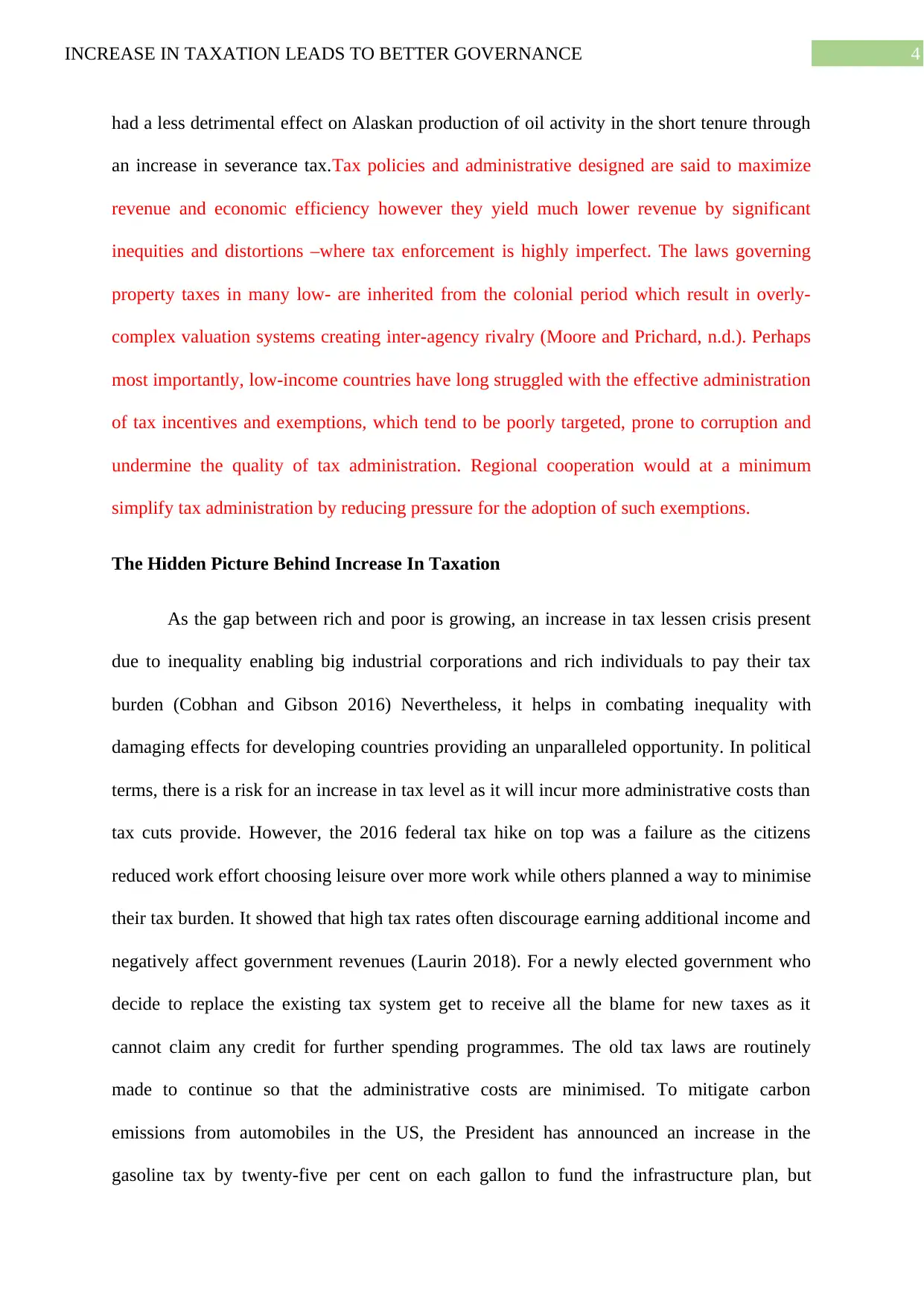
4INCREASE IN TAXATION LEADS TO BETTER GOVERNANCE
had a less detrimental effect on Alaskan production of oil activity in the short tenure through
an increase in severance tax.Tax policies and administrative designed are said to maximize
revenue and economic efficiency however they yield much lower revenue by significant
inequities and distortions –where tax enforcement is highly imperfect. The laws governing
property taxes in many low- are inherited from the colonial period which result in overly-
complex valuation systems creating inter-agency rivalry (Moore and Prichard, n.d.). Perhaps
most importantly, low-income countries have long struggled with the effective administration
of tax incentives and exemptions, which tend to be poorly targeted, prone to corruption and
undermine the quality of tax administration. Regional cooperation would at a minimum
simplify tax administration by reducing pressure for the adoption of such exemptions.
The Hidden Picture Behind Increase In Taxation
As the gap between rich and poor is growing, an increase in tax lessen crisis present
due to inequality enabling big industrial corporations and rich individuals to pay their tax
burden (Cobhan and Gibson 2016) Nevertheless, it helps in combating inequality with
damaging effects for developing countries providing an unparalleled opportunity. In political
terms, there is a risk for an increase in tax level as it will incur more administrative costs than
tax cuts provide. However, the 2016 federal tax hike on top was a failure as the citizens
reduced work effort choosing leisure over more work while others planned a way to minimise
their tax burden. It showed that high tax rates often discourage earning additional income and
negatively affect government revenues (Laurin 2018). For a newly elected government who
decide to replace the existing tax system get to receive all the blame for new taxes as it
cannot claim any credit for further spending programmes. The old tax laws are routinely
made to continue so that the administrative costs are minimised. To mitigate carbon
emissions from automobiles in the US, the President has announced an increase in the
gasoline tax by twenty-five per cent on each gallon to fund the infrastructure plan, but
had a less detrimental effect on Alaskan production of oil activity in the short tenure through
an increase in severance tax.Tax policies and administrative designed are said to maximize
revenue and economic efficiency however they yield much lower revenue by significant
inequities and distortions –where tax enforcement is highly imperfect. The laws governing
property taxes in many low- are inherited from the colonial period which result in overly-
complex valuation systems creating inter-agency rivalry (Moore and Prichard, n.d.). Perhaps
most importantly, low-income countries have long struggled with the effective administration
of tax incentives and exemptions, which tend to be poorly targeted, prone to corruption and
undermine the quality of tax administration. Regional cooperation would at a minimum
simplify tax administration by reducing pressure for the adoption of such exemptions.
The Hidden Picture Behind Increase In Taxation
As the gap between rich and poor is growing, an increase in tax lessen crisis present
due to inequality enabling big industrial corporations and rich individuals to pay their tax
burden (Cobhan and Gibson 2016) Nevertheless, it helps in combating inequality with
damaging effects for developing countries providing an unparalleled opportunity. In political
terms, there is a risk for an increase in tax level as it will incur more administrative costs than
tax cuts provide. However, the 2016 federal tax hike on top was a failure as the citizens
reduced work effort choosing leisure over more work while others planned a way to minimise
their tax burden. It showed that high tax rates often discourage earning additional income and
negatively affect government revenues (Laurin 2018). For a newly elected government who
decide to replace the existing tax system get to receive all the blame for new taxes as it
cannot claim any credit for further spending programmes. The old tax laws are routinely
made to continue so that the administrative costs are minimised. To mitigate carbon
emissions from automobiles in the US, the President has announced an increase in the
gasoline tax by twenty-five per cent on each gallon to fund the infrastructure plan, but
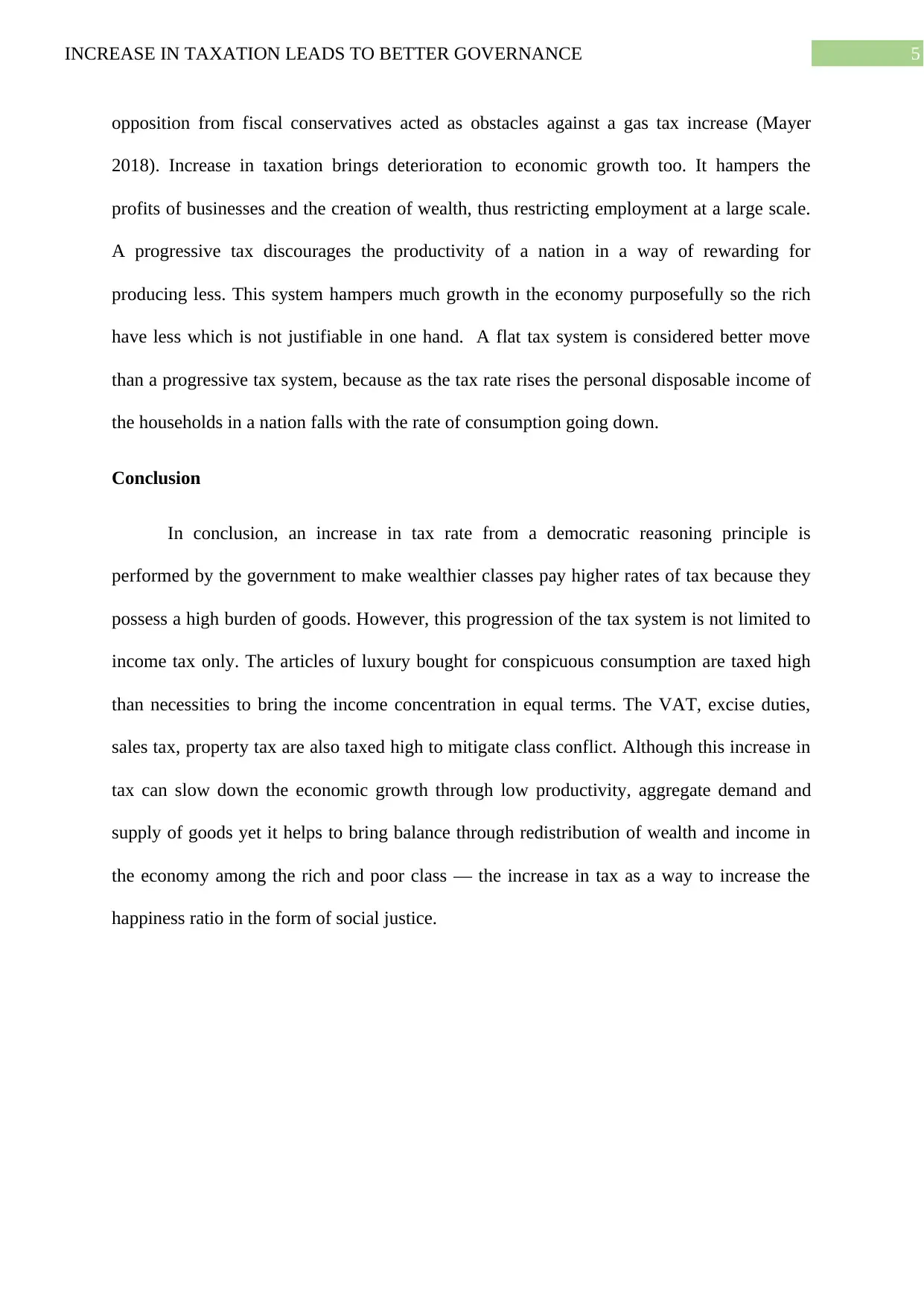
5INCREASE IN TAXATION LEADS TO BETTER GOVERNANCE
opposition from fiscal conservatives acted as obstacles against a gas tax increase (Mayer
2018). Increase in taxation brings deterioration to economic growth too. It hampers the
profits of businesses and the creation of wealth, thus restricting employment at a large scale.
A progressive tax discourages the productivity of a nation in a way of rewarding for
producing less. This system hampers much growth in the economy purposefully so the rich
have less which is not justifiable in one hand. A flat tax system is considered better move
than a progressive tax system, because as the tax rate rises the personal disposable income of
the households in a nation falls with the rate of consumption going down.
Conclusion
In conclusion, an increase in tax rate from a democratic reasoning principle is
performed by the government to make wealthier classes pay higher rates of tax because they
possess a high burden of goods. However, this progression of the tax system is not limited to
income tax only. The articles of luxury bought for conspicuous consumption are taxed high
than necessities to bring the income concentration in equal terms. The VAT, excise duties,
sales tax, property tax are also taxed high to mitigate class conflict. Although this increase in
tax can slow down the economic growth through low productivity, aggregate demand and
supply of goods yet it helps to bring balance through redistribution of wealth and income in
the economy among the rich and poor class — the increase in tax as a way to increase the
happiness ratio in the form of social justice.
opposition from fiscal conservatives acted as obstacles against a gas tax increase (Mayer
2018). Increase in taxation brings deterioration to economic growth too. It hampers the
profits of businesses and the creation of wealth, thus restricting employment at a large scale.
A progressive tax discourages the productivity of a nation in a way of rewarding for
producing less. This system hampers much growth in the economy purposefully so the rich
have less which is not justifiable in one hand. A flat tax system is considered better move
than a progressive tax system, because as the tax rate rises the personal disposable income of
the households in a nation falls with the rate of consumption going down.
Conclusion
In conclusion, an increase in tax rate from a democratic reasoning principle is
performed by the government to make wealthier classes pay higher rates of tax because they
possess a high burden of goods. However, this progression of the tax system is not limited to
income tax only. The articles of luxury bought for conspicuous consumption are taxed high
than necessities to bring the income concentration in equal terms. The VAT, excise duties,
sales tax, property tax are also taxed high to mitigate class conflict. Although this increase in
tax can slow down the economic growth through low productivity, aggregate demand and
supply of goods yet it helps to bring balance through redistribution of wealth and income in
the economy among the rich and poor class — the increase in tax as a way to increase the
happiness ratio in the form of social justice.
⊘ This is a preview!⊘
Do you want full access?
Subscribe today to unlock all pages.

Trusted by 1+ million students worldwide

6INCREASE IN TAXATION LEADS TO BETTER GOVERNANCE
References
Atkinson, A.B., Leventi, C., Nolan, B., Sutherland, H. and Tasseva, I., 2017. Reducing
poverty and inequality through tax-benefit reform and the minimum wage: the UK as a case
study. The Journal of Economic Inequality, 15(4), pp.303-323.
Cobham, A. and Gibson, L., 2016. Ending the Era of Tax Havens: Why the UK government
must lead the way.
Esser, M.B., Waters, H., Smart, M. and Jernigan, D.H., 2016. Impact of Maryland’s 2011
alcohol sales tax increase on alcoholic beverage sales. The American journal of drug and
alcohol abuse, 42(4), pp.404-411.
Ghodsi, Z. and Webster, A., 2018. UK Taxes and Tax Revenues: Composition and Trends.
Taxes and Taxation Trends, p.83.
Laurin, A., 2018. Unhappy Returns: A Preliminary Estimate of Taxpayers Responsiveness to
the 2016 Top Tax Rate Hike. CD Howe Institute e-Brief, 283.
Lee, S. and Park, K., 2018. Attitudes toward welfare expansion with a tax increase in South
Korea. Korean Political Science Review, 52(3).
Liu, Y. and Feng, H., 2015. Tax structure and corruption: cross-country evidence. Public
Choice, 162(1-2), pp.57-78.
References
Atkinson, A.B., Leventi, C., Nolan, B., Sutherland, H. and Tasseva, I., 2017. Reducing
poverty and inequality through tax-benefit reform and the minimum wage: the UK as a case
study. The Journal of Economic Inequality, 15(4), pp.303-323.
Cobham, A. and Gibson, L., 2016. Ending the Era of Tax Havens: Why the UK government
must lead the way.
Esser, M.B., Waters, H., Smart, M. and Jernigan, D.H., 2016. Impact of Maryland’s 2011
alcohol sales tax increase on alcoholic beverage sales. The American journal of drug and
alcohol abuse, 42(4), pp.404-411.
Ghodsi, Z. and Webster, A., 2018. UK Taxes and Tax Revenues: Composition and Trends.
Taxes and Taxation Trends, p.83.
Laurin, A., 2018. Unhappy Returns: A Preliminary Estimate of Taxpayers Responsiveness to
the 2016 Top Tax Rate Hike. CD Howe Institute e-Brief, 283.
Lee, S. and Park, K., 2018. Attitudes toward welfare expansion with a tax increase in South
Korea. Korean Political Science Review, 52(3).
Liu, Y. and Feng, H., 2015. Tax structure and corruption: cross-country evidence. Public
Choice, 162(1-2), pp.57-78.
Paraphrase This Document
Need a fresh take? Get an instant paraphrase of this document with our AI Paraphraser

7INCREASE IN TAXATION LEADS TO BETTER GOVERNANCE
Madden, D., 2015. The poverty effects of a ‘fat‐tax in Ireland. Health economics, 24(1),
pp.104-121.
Matthew, N., 2017. Short-run impacts of a severance tax change: Evidence from Alaska.
Energy Policy.
Mayer, C.J., 2018. The Politics of the Gas Tax: Exploring State Politics and the Oil Industry.
Moore, M. and Prichard, W. (n.d.). Tax reform for lowincome countries: five ideas for
simplifying tax systems to fit local realities. [online] ICTD, pp.5–7. Available at:
https://opendocs.ids.ac.uk/opendocs/bitstream/handle/20.500.12413/13830/ICTD_SB_17.pdf.
Moore, M., Fjeldstad, O.-H. and Brautigam, D. (2008). Taxation and State Building in
Developing Countries. [online] Cambridge University Press, pp.1–2. Available at:
https://open.cmi.no/cmi-xmlui/bitstream/handle/11250/2474678/Taxation%20and%20State
%20Building%20in%20Developing%20Countries?sequence=1&isAllowed=y.
Rose, R. and Karran, T., 2018. Taxation by political inertia: Financing the growth of
government in Britain. Routledge.
Yu, L., Cohen, J.E., Hoe, C., Yang, T. and Wu, D., 2019. Male smoking reduction behaviour
in response to China’s 2015 cigarette tax increase. Tobacco control, pp.tobaccocontrol-2019.
Madden, D., 2015. The poverty effects of a ‘fat‐tax in Ireland. Health economics, 24(1),
pp.104-121.
Matthew, N., 2017. Short-run impacts of a severance tax change: Evidence from Alaska.
Energy Policy.
Mayer, C.J., 2018. The Politics of the Gas Tax: Exploring State Politics and the Oil Industry.
Moore, M. and Prichard, W. (n.d.). Tax reform for lowincome countries: five ideas for
simplifying tax systems to fit local realities. [online] ICTD, pp.5–7. Available at:
https://opendocs.ids.ac.uk/opendocs/bitstream/handle/20.500.12413/13830/ICTD_SB_17.pdf.
Moore, M., Fjeldstad, O.-H. and Brautigam, D. (2008). Taxation and State Building in
Developing Countries. [online] Cambridge University Press, pp.1–2. Available at:
https://open.cmi.no/cmi-xmlui/bitstream/handle/11250/2474678/Taxation%20and%20State
%20Building%20in%20Developing%20Countries?sequence=1&isAllowed=y.
Rose, R. and Karran, T., 2018. Taxation by political inertia: Financing the growth of
government in Britain. Routledge.
Yu, L., Cohen, J.E., Hoe, C., Yang, T. and Wu, D., 2019. Male smoking reduction behaviour
in response to China’s 2015 cigarette tax increase. Tobacco control, pp.tobaccocontrol-2019.
1 out of 8
Related Documents
Your All-in-One AI-Powered Toolkit for Academic Success.
+13062052269
info@desklib.com
Available 24*7 on WhatsApp / Email
![[object Object]](/_next/static/media/star-bottom.7253800d.svg)
Unlock your academic potential
Copyright © 2020–2025 A2Z Services. All Rights Reserved. Developed and managed by ZUCOL.




